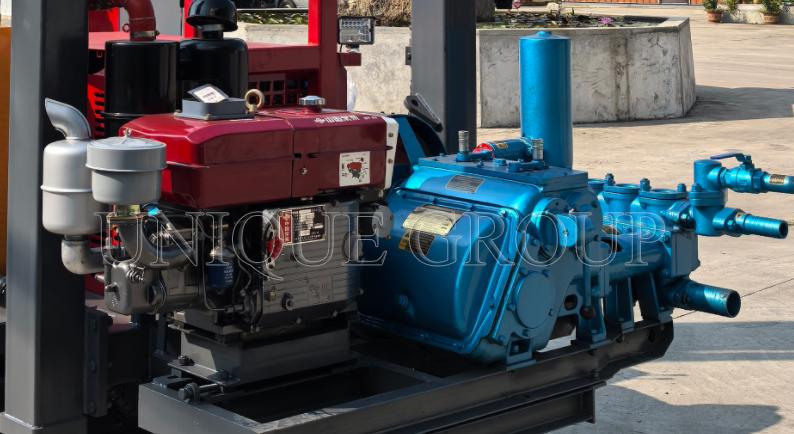Working principle and function of mud pump in hydraulic water well drilling rig

In the operation system of hydraulic water well drilling rigs, the mud pump can be called the "power heart", and its efficient operation is directly related to the success or failure of drilling operations. Next, I will deeply analyze its working principle and core role, and take you to appreciate the technical charm of this key equipment.
The working principle of the hydraulic plunger mud pump is based on the coordination of hydraulic drive and plunger reciprocating motion. The hydraulic motor in the hydraulic system, as the power source, injects kinetic energy into the crankshaft or drive shaft of the mud pump to drive it to rotate. The rotational motion of the crankshaft will be cleverly converted into the reciprocating linear motion of the plunger, thereby causing periodic changes in the volume of the pump chamber. The valve group in the pump, including the suction valve and the discharge valve, is like a precise "gatekeeper", strictly controlling the unidirectional flow of mud to ensure smooth suction and discharge.
In the specific work process, the operation of the mud pump can be divided into two key stages: suction and discharge. During the suction process, the plunger moves outward, the volume of the pump chamber expands accordingly, and the internal pressure decreases to form a negative pressure. At this time, the suction valve opens under the action of external atmospheric pressure or mud pool pressure, and the mud flows from the mud pool into the pump chamber through the suction pipe. In the discharge process, the plunger moves inward, the volume of the pump chamber decreases, the mud is compressed, and the pressure increases. The discharge valve opens immediately, and the mud is pressed into the drill pipe through the discharge pipe, and then injected into the wellbore through the drill nozzle. It is worth mentioning that the hydraulic oil will flexibly adjust the flow and pressure through the control valve group, so as to accurately control the movement frequency and stroke of the plunger, so as to adjust the displacement and output pressure of the mud pump as needed, and perfectly adapt to different drilling conditions.
Compared with mechanical mud pumps, hydraulic mud pumps have significant advantages. Hydraulic mud pumps are powered by hydraulic systems and hydraulic motors, and use hydraulic valve groups to achieve stepless adjustment of pressure and flow. They are particularly suitable for deep hole drilling, complex formation operations and automated drilling rigs. Mechanical mud pumps are mostly directly driven by diesel engines or electric motors, and rely on gear speed changes to adjust the speed. They are more suitable for shallow hole drilling, small drilling rigs and fixed working conditions.
The role of mud pumps in water well drilling rigs is crucial and is reflected in many aspects. It can effectively cool and lubricate the drill bit. The friction between the high-speed rotating drill bit and the formation will generate a lot of heat. When the mud flows through the drill bit, it can absorb the heat in time to prevent the drill bit from being worn or stuck due to overheating. In hard rock formation drilling, the cooling effect of the mud can extend the life of the drill bit by more than 30%. The mud pump can also carry rock cuttings and clean the hole. The mud passes through the drill bit nozzle at a certain flow rate, suspends the broken rock cuttings in the liquid flow, and returns to the ground along the annular space between the drill pipe and the well wall to prevent the accumulation of rock cuttings and block the wellbore. Usually, the mud flow rate needs to reach 1.5-3 meters/second to effectively carry rock cuttings with a diameter of more than 0.5mm.
In addition, the mud pump can balance the formation pressure and stabilize the wellbore. The liquid column pressure generated by the mud column can offset the formation pore pressure and prevent the wellbore from collapsing or groundwater gushing. This wall protection function is particularly critical in the drilling of loose formations such as sand layers and loess layers. In some drilling rig designs, the high-speed jet formed by the high-pressure mud through the drill bit nozzle can also assist in breaking the formation and improve drilling efficiency. At the same time, by detecting the viscosity, sand content, pressure change and other mud performance indicators of the return slurry, it is possible to judge the formation changes, drill bit wear or wellbore abnormalities, such as leakage and stuck drill.
In practical applications, the selection and maintenance of mud pumps should not be ignored. When selecting, it is necessary to reasonably select the pressure and displacement parameters of the pump based on factors such as well depth and formation type. For example, a mud pump with a displacement of 50-80L/min is usually required for a well depth of 100 meters. In terms of maintenance, it is necessary to regularly check the wear of the plunger seal and valve group to prevent the sand in the mud from scratching the pump body and affecting the efficiency of the hydraulic system.
The mud pump in the hydraulic water well drilling rig has become an indispensable and important equipment in the field of water well drilling with its exquisite working principle and multiple practical functions. Understanding its principles and functions can not only help optimize the drilling operation process, but also provide ideas for technological innovation. Welcome colleagues to share their insights in the comment area and discuss more possibilities of mud pump technology.
- Information Technology
- Office Equipment and Supplies
- Cars and Trucks
- Persons
- Books and Authors
- Tutorials
- Art
- Causes
- Crafts
- Dance
- Drinks
- Film
- Fitness
- Food
- Spiele
- Gardening
- Health
- Startseite
- Literature
- Music
- Networking
- Andere
- Party
- Religion
- Shopping
- Sports
- Theater
- Wellness



